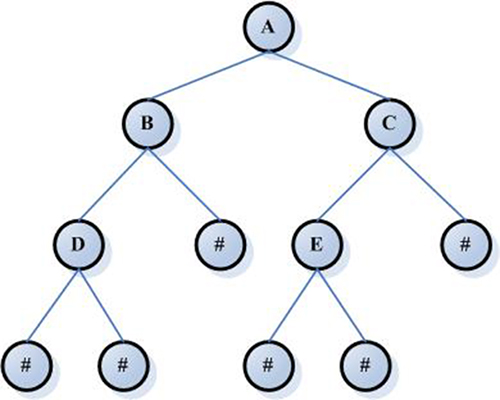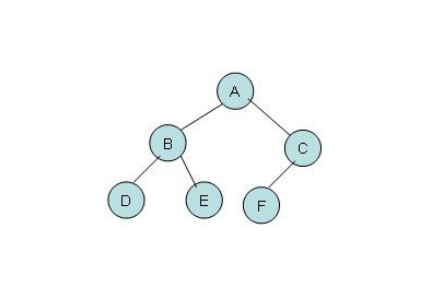
树型结构是一类非常重要的非线性结构,是以分支关系定义的层次结构。
在日常的开发中,也会遇到将数组转换为树形结构的场景。
const data = [{
id: 1,
name: '1',
}, {
id: 2,
name: '1-1',
parentId: 1
}, {
id: 3,
name: '1-1-1',
parentId: 2
}, {
id: 4,
name: '1-2',
parentId: 1
}, {
id: 5,
name: '1-2-2',
parentId: 4
}, {
id: 6,
name: '1-1-1-1',
parentId: 3
}, {
id: 7,
name: '2',
}]
把父子关系的数组转换为树形结构
function translateDataToTree(data) {
const treeData = [];
for (let i = 0; i < data.length; i++) {
let ele = data[i];
if (!ele.parentId) {
treeData.push(ele);
continue;
}
translateChildren(treeData, ele);
}
function translateChildren(arr, ele) {
arr.forEach(item => {
if (ele.parentId === item.id) {
if (!item.children) item.children = [];
item.children.push(ele);
}
if (item.children) {
translateChildren(item.children, ele);
}
})
}
return treeData;
}

二叉树(Binary Tree)的特点是每个结点至多只有两棵子树(即二叉树中不存在度大于2的结点),并且,二叉树的子树有左右之分(其次序不能任意颠倒。)

构造一棵二叉树
// 二叉树构造函数
function BinaryTree() {
// 节点的构造函数
let Node = function (key) {
this.key = key; // 节点的值
this.left = null; // 左子树节点
this.right = null; // 右子树节点
}
// 根节点
let root = null;
// 插入root的子节点
let insertNode = function (parentNode, childNode) {
// 左子树构造
if (childNode.key < parentNode.key) {
// 为空时赋值,否则继续延伸
if (parentNode.left === null) {
parentNode.left = childNode;
} else {
insertNode(parentNode.left, childNode);
}
} else { // 右子树的构造 childNode.key > parentNode.key
if (parentNode.right === null) {
parentNode.right = childNode;
} else {
insertNode(parentNode.right, childNode);
}
}
}
this.getRoot = function () {
return root;
}
// 插入节点的实例方法
this.insert = function (key) {
var thisNode = new Node(key);
// 根节点赋值
if (root === null) {
root = thisNode;
} else {
// 插入子节点
insertNode(root, thisNode);
}
}
}
let nodes = [8, 3, 10, 1, 5, 14, 4, 6, 13];
let binaryTree = new BinaryTree();
nodes.forEach(key => {
binaryTree.insert(key);
});
console.log(binaryTree.getRoot());
遍历表达法
遍历二叉树(Traversing Binary Tree):是指按指定的规律对二叉树中的每个结点访问一次且仅访问一次。
遍历表达法有4种方法:先序遍历、中序遍历、后序遍历、层次遍历
其先序遍历(又称先根遍历)为ABDECF(根-左-右)
其中序遍历(又称中根遍历)为DBEAFC(左-根-右)(仅二叉树有中序遍历)
其后序遍历(又称后根遍历)为DEBFCA(左-右-根)
其层次遍历为ABCDEF(同广度优先搜索)

JS 中的二叉树
let tree = {
value: "a",
left: {
value: 'a1',
left: {
value: 'a11',
},
right: {
value: 'b1',
left: {
value: 'b11',
},
right: {
value: 'b12',
}
}
},
right: {
value: 'c1',
left: {
value: 'c11',
},
right: {
value: 'c12',
}
}
}

深度优先遍历
先序遍历
递归遍历
let frontDFS = function(tree) {
let result = []
let dfs = function(node) {
if (node) {
result.push(node.value)
dfs(node.left)
dfs(node.right)
}
}
dfs(tree)
return result
}
// ["a", "a1", "a11", "b1", "b11", "b12", "c1", "c11", "c12"]
先遍历根结点,将值存入数组,然后递归遍历:先左结点,将值存入数组,继续向下遍历;直到(二叉树为空)子树为空,则遍历结束;然后再回溯遍历右结点,将值存入数组,这样递归循环,直到(二叉树为空)子树为空,则遍历结束。
非递归遍历
利用栈:将遍历到的结点都依次存入栈中,拿结果时从栈中访问
let frontDFS = function(tree) {
let result = []
let stack = []
stack.push(tree)
// 栈中的数据为空
while(stack.length) {
// 取栈中最后一个
let node = stack.pop()
result.push(node.value)
// 先压入右子树
if (node.right) stack.push(node.right)
// 后压入左子树
if (node.left) stack.push(node.left)
}
return result
}
// ["a", "a1", "a11", "b1", "b11", "b12", "c1", "c11", "c12"]
- 初始化一个栈,将根节点压入栈中
- 当栈为非空时,循环执行步骤3到4,否则执行结束
- 从队列取得一个结点(取的是栈中最后一个结点),将该值放入结果数组
- 若该结点的右子树为非空,则将该结点的右子树入栈,若该结点的左子树为非空,则将该结点的左子树入栈;(注意:先将右结点压入栈中,后压入左结点,从栈中取得时候是取最后一个入栈的结点,而先序遍历要先遍历左子树,后遍历右子树)
中序遍历
递归遍历
let inorderDFS = function(tree) {
let result = []
let dfs = function(node) {
if (node) {
dfs(node.left)
result.push(node.value)
dfs(node.right)
}
}
dfs(tree)
return result
}
// ["a11", "a1", "b11", "b1", "b12", "a", "c11", "c1", "c12"]
先递归遍历左子树,从最后一个左子树开始存入数组,然后回溯遍历双亲结点,再是右子树,这样递归循环。
非递归遍历
let inorderDFS = function(node) {
let result = []
let stack = []
while(stack.length || node) {
if (node) {
stack.push(node)
node = node.left
} else {
node = stack.pop()
result.push(node.value)
node = node.right
}
}
return result
}
// ["a11", "a1", "b11", "b1", "b12", "a", "c11", "c1", "c12"]
将当前结点压入栈,然后将左子树当做当前结点,如果当前结点为空,将双亲结点取出来,将值保存进数组,然后将右子树当做当前结点,进行循环。
后序遍历
递归遍历
let bebindDFS = function(tree) {
let result = []
let dfs = function(node) {
if (node) {
dfs(node.left)
dfs(node.right)
result.push(node.value)
}
}
dfs(tree)
return result
}
// ["a11", "b11", "b12", "b1", "a1", "c11", "c12", "c1", "a"]
先走左子树,当左子树没有孩子结点时,将此结点的值放入数组中,然后回溯遍历双亲结点的右结点,递归遍历。
非递归遍历
let bebindDFS = function(node) {
let result = []
let stack = []
stack.push(node)
while(stack.length) {
if (node.left && !node.touched) {
node.touched = 'left'
node = node.left
stack.push(node)
continue
}
if (node.right && node.touched !== 'right') {
node.touched = 'right'
node = node.right
stack.push(node)
continue
}
node = stack.pop()
node.touched && delete node.touched
result.push(node.value)
node = stack.length ? stack[stack.length - 1] : null
}
return result
}
// ["a11", "b11", "b12", "b1", "a1", "c11", "c12", "c1", "a"]
先把根结点和左树推入栈,然后取出左树,再推入右树,取出,最后取根结点。
- 初始化一个栈,将根节点压入栈中,并标记为当前节点(node)
- 当栈为非空时,执行步骤3,否则执行结束
- 如果当前节点(node)有左子树且没有被 touched,则执行4;如果当前结点有右子树,被 touched left 但没有被 touched right 则执行5 否则执行6
- 对当前节点(node)标记 touched left,将当前节点的左子树赋值给当前节点(node=node.left) 并将当前节点(node)压入栈中,回到3
- 对当前节点(node)标记 touched right,将当前节点的右子树赋值给当前节点(node=node.right) 并将当前节点(node)压入栈中,回到3
- 清理当前节点(node)的 touched 标记,弹出栈中的一个节点并访问,然后再将栈顶节点标记为当前节点(item),回到3
广度优先遍历
广度优先遍历二叉树(层序遍历)是用队列来实现的,广度遍历是从二叉树的根结点开始,自上而下逐层遍历;在同一层中,按照从左到右的顺序对结点逐一访问。
递归遍历
let recursionBFS = function(tree) {
let result = []
// 先将要遍历的树压入栈
let stack = [tree]
// 记录执行到第几层
let count = 0
let bfs = function() {
let node = stack[count]
if (node) {
result.push(node.value)
if (node.left) stack.push(node.left)
if (node.right) stack.push(node.right)
count++
bfs()
}
}
bfs()
return result
}
// ["a", "a1", "c1", "a11", "b1", "c11", "c12", "b11", "b12"]
非递归算法
let BFS = function(node) {
let result = []
let queue = []
queue.push(node)
let pointer = 0
while(pointer < queue.length) {
let node = queue[pointer++]
result.push(node.value)
node.left && queue.push(node.left)
node.right && queue.push(node.right)
}
return result
}
// ["a", "a1", "c1", "a11", "b1", "c11", "c12", "b11", "b12"]
LeetCode
102. 二叉树的层序遍历
var levelOrder = function (root) {
let res = [], que = [root];
if (!root) {
return [];
}
while (que.length) {
let temp = [], ans = [];
for (let i = 0; i < que.length; i++) {
ans.push(que[i].val);
if (que[i].left) {
temp.push(que[i].left);
}
if (que[i].right) {
temp.push(que[i].right);
}
}
res.push(ans);
que = temp;
}
return res;
};
104. 二叉树的最大深度
BFS,广度优先遍历。每一次用一个数组temp保存上一层的所有节点,每次计数器count+1。当temp为空的时候,也就是此时都是叶子节点情况。
var maxDepth = function (root) {
if (!root) return 0;
let queue = [root], res = 0;
while (queue.length) {
let temp = [];
for (let i = 0; i < queue.length; i++) {
if (queue[i].left) temp.push(queue[i].left);
if (queue[i].right) temp.push(queue[i].right);
}
res += 1;
queue = temp;
}
return res;
};
107. 二叉树的层序遍历 II
BFS 思路
BFS 是按层层推进的方式,遍历每一层的节点。题目要求的是返回每一层的节点值,所以这题用 BFS 来做非常合适。BFS 需要用队列作为辅助结构,我们先将根节点放到队列中,然后不断遍历队列。
时间复杂度:O(n)
空间复杂度:O(n)
var levelOrderBottom = function (root) {
if (!root) return [];
let res = [], queue = [root];
while (queue.length) {
let curr = [], temp = [];
while (queue.length) {
let node = queue.shift();
curr.push(node.val);
if (node.left) temp.push(node.left);
if (node.right) temp.push(node.right);
}
res.push(curr);
queue = temp;
}
return res.reverse();
};
DFS 思路
DFS 是沿着树的深度遍历树的节点,尽可能深地搜索树的分支
DFS 做本题的主要问题是: DFS 不是按照层次遍历的。为了让递归的过程中同一层的节点放到同一个列表中,在递归时要记录每个节点的深度 depth 。递归到新节点要把该节点放入 depth 对应列表的末尾。当遍历到一个新的深度 depth ,而最终结果 res 中还没有创建 depth 对应的列表时,应该在 res 中新建一个列表用来保存该 depth 的所有节点。
时间复杂度:O(n)
空间复杂度:O(h),h为树的高度
var levelOrderBottom = function (root) {
const res = [];
let dep = function (node, depth) {
if (!node) return;
res[depth] = res[depth] || [];
res[depth].push(node.val);
dep(node.left, depth + 1);
dep(node.right, depth + 1);
};
dep(root, 0);
return res.reverse();
};
二叉树的实际应用(应用场景)
- 哈夫曼编码,来源于哈夫曼树(给定n个权值作为n个叶子结点,构造一棵二叉树,若带权路径长度达到最小,称这样的二叉树为最优二叉树,也称为赫夫曼树(Huffman tree)。即带权路径长度最短的树),在数据压缩上有重要应用,提高了传输的有效性,详见《信息论与编码》。
- 海量数据并发查询,二叉树复杂度是O(K+LgN)。二叉排序树就既有链表的好处,也有数组的好处, 在处理大批量的动态的数据是比较有用。
- Java集合中的TreeSet和TreeMap,C++ STL中的set/multiset、map,以及Linux虚拟内存的管理,都是通过红黑树去实现的。查找最大(最小)的k个数,红黑树,红黑树中查找/删除/插入,都只需要O(logk)。
- B-Tree,B±Tree在文件系统中的目录应用。
- 路由器中的路由搜索引擎。
今天你学废了吗?

参考文章:






















 624
624











 被折叠的 条评论
为什么被折叠?
被折叠的 条评论
为什么被折叠?








